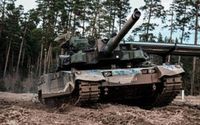Poland has finalized a landmark contract to purchase 180 K2 Black Panther tanks from South Korea’s Hyundai Rotem, marking the largest single export deal in the history of Korea’s defense industry. The deal, valued at approximately 9 trillion won (around US$6.5 to $6.7 billion), was officially announced on July 2, 2025, by Polish Defense Minister Władysław Kosiniak-Kamysz and confirmed by South Korea’s Defense Acquisition Program Administration (DAPA).
This second K2 tank contract represents a significant evolution from the initial 2022 agreement under which Poland procured 180 tanks alongside other weapon systems such as K9 self-propelled howitzers, FA-50 light strike fighters, and Chunmoo multiple launch rocket systems. The original framework contract was part of Poland’s urgent response to heightened security concerns following Russia’s invasion of Ukraine, leading to a comprehensive $12.3 billion arms deal with South Korea.
Unlike the first batch of tanks, which were fully manufactured in South Korea, the new contract includes the development and transfer of “Polish-style” K2 tanks—customized to meet the specific operational requirements of the Polish military. A crucial component of the deal is the establishment of a local production facility in Poland, where 63 of the 180 tanks will be assembled by the Polish state-owned defense group PGZ in collaboration with Hyundai Rotem. The remaining 117 units will be produced and supplied directly from South Korea.
The inclusion of local production and technology transfer significantly increased the contract’s value from the initial 4.5 trillion won to nearly double, reflecting the added costs and complexities of developing a Polish variant and manufacturing infrastructure. DAPA highlighted that this local production foothold enhances the possibility of future contracts for the remaining 820 K2 tanks envisaged in the original framework agreement, potentially scaling Poland’s armored capabilities substantially.
Negotiations for this second contract were protracted, delayed beyond the initially expected April 2025 signing date. Several factors contributed to the extended talks, including the expanded scope of technology transfer, the scale of local production, and political instability in both countries. Notably, South Korea faced domestic turmoil following the unexpected declaration of martial law by former President Yoon Suk-yeol in December 2024, which created leadership vacuums in the presidency and Defense Ministry, delaying government guarantees essential for the deal.
Despite these challenges, the contract was finalized with high-level cooperation between the private sector, government agencies, and the military. DAPA Commissioner Seok Jong-gun remarked, “This second export contract for K2 tanks is the result of combined efforts by the private sector, government, and military to keep the furnace of defense exports burning despite challenging conditions.” He added, “This contract will serve as an opportunity to confirm that defense cooperation between Korea and Poland will continue solidly.”
The deal aligns closely with the European Union’s Readiness 2030 plan, announced in March 2025, which seeks to enhance defense capabilities across member states through modernization and local manufacturing initiatives. By enabling customized upgrades and local assembly, the K2 tank contract exemplifies this strategic vision, fostering interoperability within NATO and strengthening European defense autonomy.
Poland’s decision to deepen its defense ties with South Korea through this contract underscores its commitment to modernizing its military amid ongoing regional security threats. The K2 Black Panther is considered one of the world’s most advanced main battle tanks, featuring cutting-edge firepower, mobility, and protection systems. Its deployment will significantly boost Poland’s armored warfare capabilities, complementing other acquisitions like the K9 howitzers and FA-50 aircraft.
Moreover, the contract is a milestone for South Korea’s defense industry, marking the first major export deal under President Lee Jae-myung’s administration. It demonstrates Korea’s growing role as a key player in the global arms market, particularly in supplying advanced systems to NATO and European allies. The deal is expected to generate momentum for further arms exports to other European nations, leveraging Korea’s reputation for high-performance military technology combined with competitive production costs.
The contract signing ceremony is anticipated to be a high-profile event, with senior officials from both countries expected to attend. Current plans suggest Polish dignitaries may travel to South Korea following the inauguration of the next Korean Minister of National Defense to formalize the agreement, symbolizing a deepening bilateral defense partnership.
Since the initial 2022 framework deal, individual contracts for other weapon systems have progressed steadily, including a 2023 contract for 152 K9 self-propelled howitzers and a 2024 agreement for Chunmoo multiple launch rocket systems. The successful conclusion of the second K2 tank contract completes a critical component of Poland’s comprehensive modernization effort.
In the words of DAPA Minister Seok Jong Gun, “We will keep up full support so that the K2 tank can be responsible for not only Korea’s national security but Europe’s as well.” This statement captures the broader strategic significance of the deal, positioning the K2 tank as a symbol of international defense cooperation and shared security interests between South Korea and Poland.
As Poland moves forward with local production, the collaboration between Hyundai Rotem and Polish defense companies is poised to create jobs, develop domestic expertise, and foster technological innovation within Poland’s defense sector. This partnership model could serve as a blueprint for future international defense collaborations, balancing advanced technology transfer with local industrial development.
Overall, this contract marks a new chapter in Korea-Poland defense relations, blending cutting-edge technology, industrial cooperation, and strategic alignment with broader European defense initiatives. It highlights how global defense partnerships are evolving to meet complex geopolitical challenges by combining performance, customization, and local engagement.

